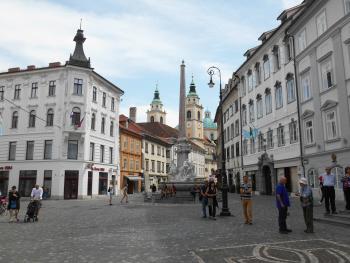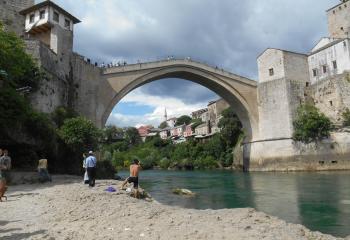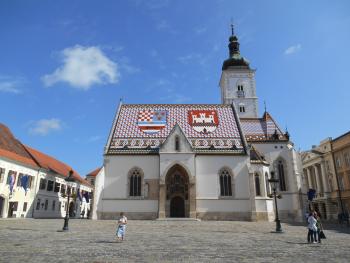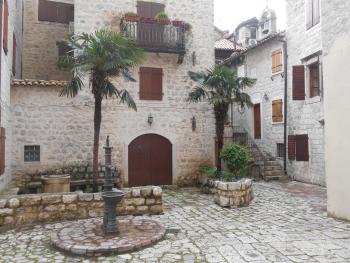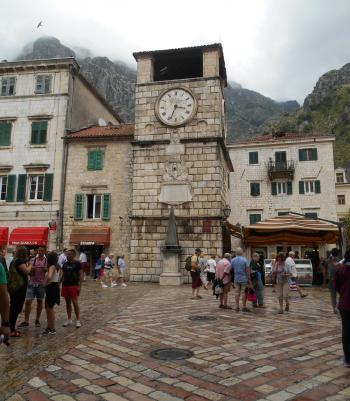Traveling through ‘Titoland’– a rail adventure through the countries once collectively called Yugoslavia
This article appears on page 6 of the February 2017 issue.
The white stone of the Triple Bridge shimmered in the evening lights. In the background, the pink façade of the Franciscan church off Prešernov trg provided a beautiful color contrast. What an impressive sight on the first evening of my May 2016 adventure in “Titoland”!
An adventure begins
The UK-based adventure-tour provider Explore! (US phone, 510/227-8224; www.exploreworldwide.
com) was offering a brand-new tour titled “Former Yugoslavia Rail Adventure,” and I was a participant on the very first departure. The tour included the seven current countries whose lands comprised the former Yugoslavia under Marshal Josip Broz Tito.
During a 2006 Balkan tour, I had visited the more “touristy” countries in the region, including Slovenia, Croatia, Macedonia, and the, then, newly independent Montenegro, but I missed out on seeing the more rarely visited Bosnia & Herzegovina and Serbia. Of course, at the time (and up until very recently), the now-independent Kosovo was just a province of Serbia.
Like me, most of our group of 16 adventurers arrived at Ljubljana, the capital of Slovenia, in the early evening of the first day. It was too late for sightseeing, but there was time to stroll to the central area around Prešernov trg and Old Town. I enjoyed exploring the lively cafés and nightlife along the Ljubljanica River.
The more physically fit of our group, which didn’t include me, climbed the hill to Ljubljana Castle to view a panorama of the city in the setting sun.
Following a delicious dinner on Old Town’s Ribji trg (Fish Square), on the patio in front of Ljubljana’s oldest house, it was time to turn in for the night.
After a satisfying buffet breakfast at our first night’s lodging, Hotel Park (www.hotelpark.si), we began our city tour with the local guide. Since we were scheduled for a late-afternoon train ride to Zagreb, Croatia, there wasn’t a whole lot of time to take in Ljubljana’s offerings.
In Old Town, we made stops at St. Nicholas’ Cathedral, Mestni trg (with its Robba Fountain) and the Town Hall. Our limited time forced us to bypass Stari trg (Old Square), which our guide described as a warren of quiet courtyards, cobblestone walkways and medieval houses.
Heading over the Triple Bridge and across the river, we again appreciated the architecture of Prešernov trg, this time in daylight. The pink Franciscan church hadn’t moved from its location the previous evening, and Palacˇa Urbanc, a 1903 building, impressed us with its elegant design.
Our last stops on the guided tour included the National Assembly Building, the unusual monument on the nearby Trg Republike and the Slovene National Theatre Opera & Ballet Ljubljana.
Continuing to Croatia
The group arrived at Zagreb’s railway station about 7 p.m. Our hotel, Hotel Central (www.hotel-central.hr), was located almost directly across the street.
Our tour leaders, Dmitri and Elena, took us on a short orientation walk to Zagreb’s main square, Trg bana Jelacˇic´a, where the group broke up to independently explore dinner options.
The next morning, the local guide met us at our hotel and escorted us, with commentary, along Praška Street, adjacent to the beautifully green Trg Nikole Šubic´a Zrinskog and past Trg bana Jelacˇic´a, ultimately leading us to Trg Kaptol, with its Cathedral of the Assumption of the Blessed Virgin Mary.
Trg bana Josipa Jelacˇic´a is located at the edge of Zagreb’s Lower Town, and Trg Kaptol and the cathedral mark the start of the Upper Town, the oldest area, containing the city’s historical buildings and churches.
After a tour of the cathedral, we sauntered into the Upper Town, passing through the landmark Stone Gate, now a shrine.
Our guided morning tour ended as we descended back to the Lower Town via the cobbled Zakmardijeve Stube, a pedestrian walkway. Our long day of sightseeing was barely at its halfway point.
After a brief time for refreshment at one of the outdoor cafés near Trg bana Josipa Jelacˇic´a, we boarded a bus for the 3-hour drive south to Plitvicˇe Lakes National Park. I think everyone in the group quickly realized why this park is such a popular tourist stop as we explored the sparkling, emerald lakes connected by picturesque cascades and waterfalls.
Bosnia & Herzegovina
The next morning, the fifth day, we began our train journey to Sarajevo, Bosnia & Herzegovina. Our train was a local that made numerous stops for commuters at both the beginning and end of the trip, but, once we crossed the border from Croatia into Bosnia & Herzegovina, the contrasting mountain scenery was amazing.
After about eight hours, we arrived in the city of Sarajevo.
Explore! let no grass grow under its clients’ feet. Despite the approaching sunset, after checking in at Hotel Grand (hotelgrand.com), Dmitri ordered taxis to take us to Bašcˇaršija, Sarajevo’s Old Town, entering at the historic Pigeon Square. The sight of the ornate Sebilj, an 18th-century drinking fountain, greeted us.
After a quick scout around the immediate area, Dmitri led us to the steak house, Bosanska Kuca (Bravadžiluk 3) for a “dutch treat” dinner.
In the morning, the group reconvened on the bridge over the Miljacka River near Vijec´nica (City Hall). From one side of the bridge, at the crest of the hills, we had a view of Vratnik Citadel. From the other side, we were directly in front of Vijec´nica, a beautiful Austro-Hungarian-era building with a Moorish façade.
Crossing the bridge to the Vijec´nica side, we revisited Bašcˇaršija, strolling the lanes and courtyards of this fascinating area and peering into the windows of copper shops and jewelry stores. Our major stop was Gazi Husrev-bey Mosque, a beautiful complex with magnificent oriental embellishments.
We eventually wandered our way around to the riverside Latin Bridge, where the assassination of Archduke Franz Ferdinand took place in 1914. It was thrilling to walk across the bridge, listen to our guide tell the stories and realize that we were in the precise spot of a major historical world event.
Just off one end of the bridge, we visited Sarajevo Museum 1878-1918, a small historical museum that featured exhibits on Sarajevo’s history and displays pertaining to the assassination.
Additional stops on our guided tour included Taslihan, an archaeological site with ruins of a caravanserai; the Eternal Flame, a memorial for combatants in World War II, and the Serbian Orthodox Cathedral.
With the afternoon free, I headed back out into the city, passing a colorful street market and the Catholic cathedral on my way to the Jewish Museum, a Sephardic Synagogue built in 1581, where I admired the restored interior and its exhibits of Jewish life in Sarajevo, past and present.
My final sightseeing stop of the day was at Svrzo’s House, a restored, furnished, 18th-century house. This museum provides an authentic idea of life in Sarajevo during a past era.
For dinner, Dmitri recommended Element (Tešanjska 24a), the rooftop restaurant in the Avaz Twist Tower. He escorted a few “takers,” including me, and we had some fine views as well as good food.
Meandering through Mostar
The next morning we were originally scheduled to travel from Sarajevo to Mostar by train, but track work due to recent flooding resulted in a change in plans. Instead, we made the 3-hour drive by private coach.
Our hotel, the new, modern City Hotel (city-hotel.ba), was in the new part of town, in the area of the university. We had only the afternoon for sightseeing in Mostar, so we checked in and rushed directly out with our local guide, headed for the historical area.
I had seen so many photos of Mostar’s Stari Most that finally seeing it for real was like a fairy tale come true. This 16th-century bridge long withstood the test of time, only to be destroyed during the 1990s Yugoslav Wars. It has been meticulously reconstructed.
Because of my mobility issues, I struggled down the steep steps, but the magnificent view from below, looking up at Stari Most, was worth every iota of discomfort.
In some ways, however, the rest of our visit to Mostar’s historical area was a disappointment. The Turkish Quarter, with its Tabhana, where the ancient tannery was located, was picturesque, but the whole area was dense with people, and the high, smoothly rounded cobblestones were hard to navigate.
Mostar seemed, to me, to be more commercialized and less authentic than was Sarajevo.
After three nights in Bosnia & Herzegovina, we crossed back into Croatia by bus.
I think that even the most frequent of world travelers, no matter how many times he or she has visited before, must be thrilled anew by the experience of ambling through and exploring the walled city of Dubrovnik.
After we passed through the main Pile Gate, Dmitri gave us two hours to enjoy the city independently.
Heading to Serbia
Following our visit to Dubrovnik, we continued on a scenic drive along the Bay of Kotor, crossing the border into Montenegro and continuing on to the city of Kotor.
We did not need a guide to navigate this tiny city, so Dmitri turned us loose again for two hours. In my wanderings, I explored the narrow, winding streets and photogenic courtyards and came upon sites such as the Clock Tower, St. Tryphon’s Cathedral, the Gurdic´ Gate and St. Nicholas’ Church.
After our two hours, we continued onward through a traffic jam in the city of Budva, finally reaching our night’s lodging, the Terminus Hotel, located near the railway station of Podgorica, the capital city of Montenegro.
This was a stop for the night only, as we departed on an early train to Belgrade, Serbia, the next morning.
Theodore Liebersfeld’s tale continues next month with him heading, by train, to Serbia.

